Round two of Middle-earth March Madness is upon us! Having summarized who the Silmarillion characters were in Round 1, we wanted to follow up with a few details on the characters in the “Other” category. As with the Silmarillion article, this one contains spoilers for those of you who haven’t picked up some of J.R.R. Tolkien’s writings outside of The Hobbit and The Lord of the Rings. Although there are some spoilers, there’s much more to most of the stories below. So, hopefully, learning a little more about them will inspire you to go to the library or bookstore and look into the characters more!
The Blue Wizards vs. Eorl
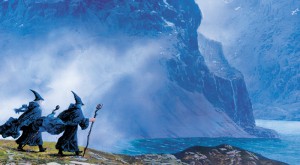
The Blue Wizards (The Istari, Unfinished Tales) – The chapter “The Istari” in Unfinished Tales tells of how the Valar, not wanting to interfere directly with efforts to defeat Sauron in Middle-earth, decided to send emissaries instead. The Blue Wizards, Alatar and Pallando, were two of the five Maiar sent to Middle-earth by the Valar to help defeat Sauron, who was also one of the Maiar. Manwe first asked for volunteers and only Curumo (Saruman) and Alatar stepped forward. Olorin (Gandalf) declined to go, saying he was too weak to take on Sauron directly. However, Manwe, saying that his humility was exactly why he was perfect for the job, ordered him to go. Curumo then took Aiwendil (Radagast) at the insistence of Yavanna, and Alatar took Pallando as a friend.
After arriving in Middle-earth, the two Blue Wizards eventually hooked up with Saruman and went with him ‘into the East,’ never to be heard of again. According to Christopher Tolkien, his father only mentioned them one more time in one of his letters:
“I think they went as emissaries to distant regions, East and South… missionaries to enemy-occupied lands, as it were. What success they had I do not know; but I fear that they failed, as Saruman did, though doubtless in different ways; and I suspect they were founders… of secret cults and “Magic” traditions that outlasted the fall of Sauron.” – Letter 211, The Letters of J.R.R. Tolkien
So, as with many of Tolkien’s ‘unfinished tales,’ we’re left to speculate on what eventually happened to Allatar and Pallando. As Maiar, essentially the same ‘order’ of being as Sauron, all of the Istari, including the Blue Wizards, were powerful beings in their own right, ‘having many powers of mind and hand.’ Being immortal, perhaps one of them eventually took the name Merlin and helped a young king, or perhaps one or both of them became founders of houses of wizards that later came to fame at a certain university for young wizards and witches. 😉
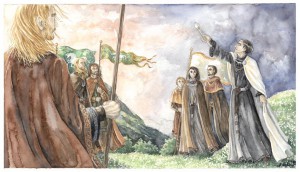
Eorl the Young (Cirion and Eorl and the Friendship of Gondor and Rohan, Unfinished Tales) – Eorl, also known as Eorl the Young, was the leader of the Eothed, a people who lived near the sources of the Anduin. He was so named because he succeeded his father when he was only 21. When an errand rider from Gondor brought a request from Cirion, the Steward of Gondor, for aid in fighting the men of Rhun, Eorl agreed to go, knowing that if Gondor fell, his own people would soon be in danger. The combined forces of Eorl and Cirion defeated Gondor’s enemies in the Battle of the Field of Celebrant in the year 2510 of the Third Age. As a token of gratitude, Cirion presented Eorl with the lands later called Rohan. Eorl accepted the gift and became the first king of Rohan, swearing an oath that the people of Rohan would ever come to the aid of Gondor in times of great need; an oath a later king of Rohan, Theoden, would honor over 500 years later in The Lord of the Rings.
Hurin vs. Chrsophylax
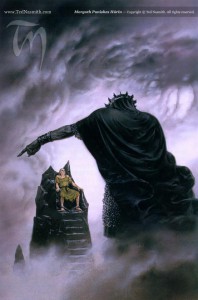
Hurin (Unfinished Tales/The Silmarillion) – Known as the mightiest of warriors of mortal men, Hurin, Lord of Dor-Lomin, was the husband of Morwen and father to daughter Nienor and son Turin. In the First Age battle of Nirnnaeth Arnoediad, all the warriors of Dor-lomin were slain except Hurin who was buried under a pile of dead orcs. Gothmog, lord of the Balrogs found him there and took him to Morgoth. When Hurin refused to tell Morgoth where to find the lost city of Gondolin, Morgoth chained him to a seat on top of the peaks of his fortress of Thangorodrim. As if that wasn’t bad enough, Morgoth cursed Hurin so he could see, through Morgoth’s own eyes, all the tragedies that befell his children (many of which were brought on by Morgoth himself).
Hurin endured the seat and the visions for twenty eight years before Morgoth finally let him go. Old, but still hale, Hurin eventually found Morwen, but only moments before she died. Then, heartbroken and angry at being turned away after trying to return to Gondolin, his loud rantings outside the gate accidentally revealed the location of Gondolin to Morgoth. Eventually, Hurin realized that all his deeds had aided Morgoth, and he cast himself into the sea. No happy endings for Hurin and his kin.
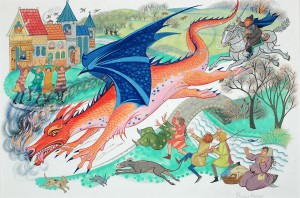
Chrysophylax the dragon (Farmer Giles of Ham) – After Farmer Giles shot a deaf, near-sighted giant who had stumbled onto his land, the giant (whos hides are a thick as Trolls’) thought he’d been stung by an insect. Back at home, he reported that there were no knights guarding the farmlands any more, just stinging insects. In time, word of this came to Chrysophylax the dragon, who decided it was about time to plunder the farmlands (now that the danger of coming to bodily harm was little to none). You see, Chysophylax was “cunning, inquisitive, greedy, well-armoured but not overly bold, ” and he was mortally hungry.
After burning down several neighboring villages and dining on the inhabitants, everyone turned to Farmer Giles to stop the destruction. Farmer Giles had become quite the local hero after driving off the giant, and had been awarded what conveniently turned out to be the magic, dragon-fighting sword Caudimorax by the King. Chrysophylax was soon cowering before them, but being very cunning (as dragons are), he cried great dragon tears and promised the villagers he would bring them all of his wealth if they spared his life. Already counting their non-existent riches, the villagers agreed. Chrysophlax promptly left and did not return on the promised day.
The King, also counting his non-existent wealth, sent all his knights, led by Farmer Giles, to make the dragon honor his promise. Being pretty cunning himself, Farmer Giles made the dragon return and, to add insult to injury, made Chrysophylax carry all the treasure on his back! Knowing the King would be powerless to wrest the treasure away with a dragon at bay, Farmer Giles kept the treasure and used the threat of Caudimorax to keep Chrysophylax on hand to help guard it. Once the now fabulously wealthy Farmer Giles became a king in his own right, he released Chrysophylax (who was expensive to feed and kept growing and growing as dragons will), who returned to his home to begin rebuilding his hoard and have a few words with a certain giant!
Trotter the Hobbit vs. Roverandom
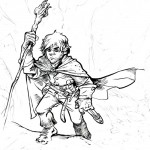
Trotter the Hobbit (Trotter and the Journey to Weathertop, The History of Middle-earth – The Return of the Shadow) – Believe it or not, in earlier drafts of the stories that eventually became The Lord of the Rings, Frodo’s name was Bingo, Sam’s name was Frodo and Strider wasn’t a man at all, but a sturdy Hobbit named Trotter! Trotter and the Journey to Weathertop is the ninth chapter in The Return of the Shadow, one of a series of excerpts of Tolkien’s writings edited by Christopher Tolkien. Other than the names, the chapter bears a striking resemblance to the chapter, At the Sign of the Prancing Pony in The Lord of the Rings. So, if you’re considering voting for Trotter, think ‘Aragron, but shorter!’
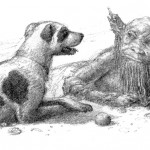
Roverandom (Roverandom) – J.R.R. Tolkien wrote Roverandom in 1925 to console his son Michael who had lost his toy dog at the beach. Rover starts out as a young puppy, white with black ears. One day, he was playing in the garden with his yellow ball when the wizard, Artaxerxes, came along and picked it up. When the wizard refused to give the ball back Rover bit his trousers and, in retaliation, the wizard turned Rover into a small toy dog. Rover was soon turned into a real dog again by the sand-sorcerer, Psamathos, but a dog of very small size. The remainder of the story follows Rover’s adventures in his effort to find the wizards to turn him back into a normal dog. Rover’s adventures include being flown to the Moon by a seagull and meeting the Man in the Moon. The Man in the Moon renames Rover “Roverandom” and gives him wings so he can play with his pet Moon-dog (also named Rover). Eventually, Roverandom goes to the bottom of the sea in search of Artaxerxes and (after many more adventures, of course), he gets his wish and is turned back into a normal dog.
Aldarion vs. Legolas of Gondolin
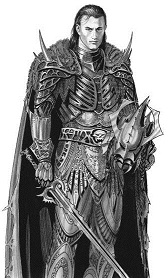
Aldarion (Aldarion and Erendis; The Mariner’s Wife, Unfinished Tales) – Aldarion was the sixth King of Númenor whose major accomplishments were his expansion of Númenor’s maritime traditions and his Middle-earth explorations. He was married to Erendis, but his first love was the sea. He left for many months at time which eventually caused a rift between the two. A great mariner in his own right, Aldarion was interested in exploring Middle-earth and discovering the riches that could be found there. During his first journeys to Middle-earth he made the friendship of Gil-galad and Círdan, from whom he learned much about both the making and management of ships. As king, Aldarion gave aid to Gil-galad, established new havens and bases on the coasts of Middle-earth, and laid the groundwork in Númenor for the creation of a great naval power.
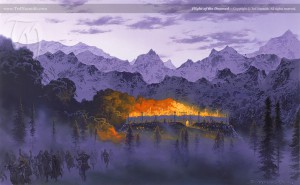
Legolas of Gondolin (The History of Middle-earth – The Book of Lost Tales, Part 2) – No, this is not the Legloas you’re probably thinking of. The first time the name of Legolas appeared in Tolkien’s writings was long before he wrote The Lord of the Rings. In The Book of Lost Tales, Part 2: The Fall of Gondolin, Tolkien tells of Galdor, the Lord of the House of Trees, for whom Legolas of Gondolin was a scout. Just as with the more famous Legolas in The Lord of the Rings, the name Legolas in The Book of Lost Tales meant ‘greenleaf’ and ’keen sight’. Many of Tolkien’s most famous characters of the First Age were in the city of Gondolin when Morgoth’s armies of orcs, dragons and balrogs attacked, including Ectheleon, Glorfindel, Tuor, his wife Idril, and her young son, Earendil, who would later become Elrond’s father. Many of them fought bravely, but when it became apparent that all was lost, they chose Legolas to lead them to safety:
“[Legolas] led the exiles over Tumladin [the plain of Gondolin] in the dark, being night-sighted …whose eyes were like cats’ for the dark, yet could they see further.”
Legolas led them over Tumladin (the plain of Gondolin) and over the treacherous Cristhorn (think Caradras). But for his keen sight, bravery and intimate knowledge of the area, they might all have been lost. After the fall of Gondolin, Legolas dwelt in Tol Eressea where he took the name Laiqulasse.
For those of you interested, descriptions of the “Other” characters that were eliminated in Round 1 are below:
Eriol (The History of Middle Earth – The Book of Lost Tales) – If it wasn’t for Eriol, we might not have The Silmarillion today. In The Book of Lost Tales, Eriol, a man, arrives as a cast away in Eressea where he meets and befriends the Elves who inhabit it. The Elves recount the history of their world to Eriol including the creation of the world, the origins of Elves, Dwarves and Men and their wars against the Enemy. These stories, of course, became the basis for many of the stories in The Book of Lost Tales and, later, The Silmarillion.
In later writings, Tolkien changed Eriol’s name to the more familiar Aelfwine (Elf-friend); the first man to find the straight road and visit Tol Eressea. Aelfwine was an Anglo-Saxon whos father sailed with Earendil and never returned. After Aelfwine’s journeys and return from Tol Eressea, he translates the stories of the Elves into what is known as The Silmarillion. Thus, Eriol (later Aelfwine) was Tolkien’s link between the tales of the Elves and the history of Great Britain.
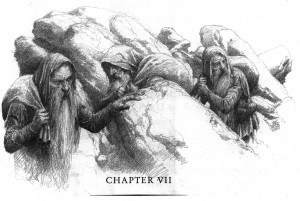
Mim the Petty Dwarf (Narn I Hin Hurin: The Tale of the Children of Hurin, Unfinished Tales)
In the saga of Turin Turambar, there came a time when he took up with a band of outlaws. Turin and the outlaws came across Mim, the Dwarf, and his two sons trying to evade the outlaws. In exchange for his life, Mim was forced to take them to his secret dwelling on the hill of Amon Rudh, which became the outlaws’ hide-out. However, one of Mim’s sons was killed, having been shot by an arrow as they tried to evade the outlaws. That, plus the fact that the outlaws bound Mim (which Dwarves never forget), plus Mim’s hatred of Turin’s Elf-friend Beleg, eventually caused Mim to betray Turin’s location to Morgoth, despite the fact that he had grown to hold a grudging respect for Turin. All of the outlaws except Turin and his friend Beleg were slain by orcs and Turin’s tragic tale continued elsewhere. Mim escaped and made his way to Nargothrond where he laid claim to the treasure there, but Turin’s father Hurin eventually found him there and killed him.
Smith of Wooten Major (Smith of Wooten Major) – In the town of Wooten Major, the Feast of the Good Children is celebrated every twenty-four years. At one such feast, the Master Cook hid trinkets in a grand cake and as one of the trinkets, his apprentice, Alf, included a little star. The star was swallowed by the blacksmith’s son who didn’t notice it at the time. However, on his tenth birthday the star fixed itself on his forehead. The boy grew up to be a blacksmith, but the star allowed him to enter the Land of Faery and protected him while he was there. In his free time he had many adventures in the Land of Faery and the folk there called him “Starbrow”. When the next Feast of the Good Children came along Smith, realizing the star was a gift from the King of Faery meant to be passed on, gave the star back to Alf who had become the Master Cook, and Smith went back to a normal life.
Niggle (Leaf by Niggle) – Niggle is a plain, unremarkable man who lives in a society that does not much value art. Nevertheless, Niggle is an artist and spends every spare moment painting a canvas of a great tree with a forest in the distance. He pays loving attention to each and every leaf, making each one uniquely beautiful. In the meantime, Niggle is distracted by real life, including a mysterious trip he must pack for and by taking time out to help his neighbor, Parish.
Niggle becomes ill after he catches a chill doing errands for Parish in the rain. He ends up in a type of institution where he is given the most mundane tasks. One night, Niggle hears the institution’s Voices discussing his case. Even though he neglected many of his duties in his former life in the pursuit of painting leaves, they give him credit for helping Parish and admit that “a Leaf by Niggle has a charm of its own.’ Niggle moves on from the institution and finds himself in a new country. He’s shocked and pleased to find his Tree there, with all its beautiful leaves, including some he hadn’t fully thought out.
Niggle is reunited with his old neighbour, Parish, who now proves his worth as a gardener, and together they make the Tree and Forest even more beautiful. Finally, Niggle journeys farther and deeper into the Forest, and beyond into the great mountains that he only faintly glimpsed in his painting.
Long after both Niggle and Parish have taken their journeys, the lovely field that they built together becomes a place for many travelers to visit before their final voyage into the Mountains, and it earns the name “Niggle’s Parish.” One perfect leaf from his original painting is framed and preserved in a museum.
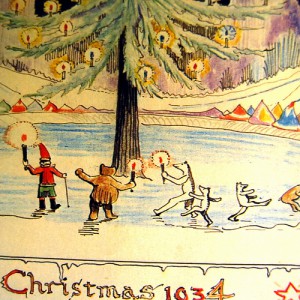
Father Christmas & North Polar Bear (The Letters of Father Christmas) – The Father Christmas Letters are a collection of letters written and illustrated by J. R. R. Tolkien between 1920 and 1942 for his children. The stories are told in a series of letters, written in the shaky handwriting of Father Christmas and ‘sent’ from the North Pole to Tolkien’s children each Christmas. It turns out that Father Christmas had many adventures throughout the year between his duties every December 24th. His sidekick, North Polar Bear, had many misadventures which kept Father Christmas especially busy. One year, the accident-prone North Polar Bear climbed the North Pole to rescue Father Christmas’ hood which blew off and was stuck there. Unfortunately, North Polar Bear fell through the roof of Father Christmas’s house into the dining room breaking his leg. North Polar Bear redeemed himself, however, in another adventure where he took on 100 goblins at once when he found out they were living in the caves beneath Father Christmas’ house.
Farmer Giles of Ham (Farmer Giles of Ham) – see Chrysophylax the dragon, above.
Tevildo, Prince of Cats (The Tale of Tinuviel, The History of Middle Earth – Book of Lost Tales Part Two) – Tevildo was the “Lord of Cats” in The Tale of Tinúviel. He appeared in the form of a great black cat with a collar of gold. During the Quest for the Silmaril, Beren was captured by Melko and sent as a servant to Tevildo. However the cat was defeated by Huan and Lúthien when they forced him to reveal the spell which held the stones of his castle together and which held cats under his evil sway. Later Tevildo’s place in the narrative was replaced by that of the Necromancer, Thû (later renamed Sauron).


